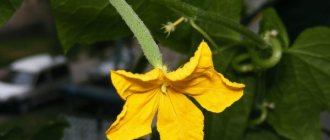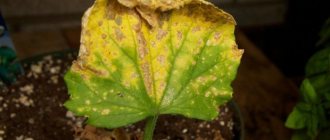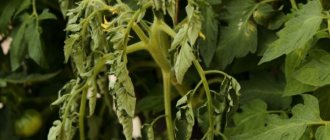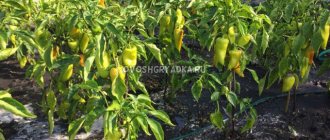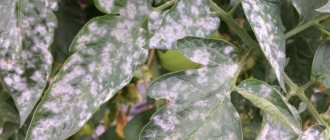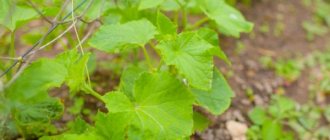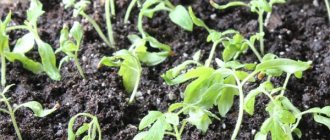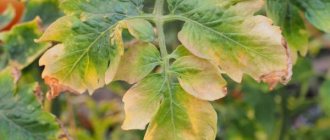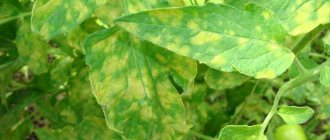The main reasons why cucumber leaves turn white
If the cucumber leaves are covered with a white coating, then the first step is to understand the reasons for its occurrence.
Lack of light
Sometimes the cause of whitening of leaves can be insufficient lighting. Most often the problem occurs when grown in a greenhouse, but it can also occur in an open area. It should be borne in mind that whitening of the lower leaves on cucumber bushes is the absolute norm, since due to their density, they do not receive enough sunlight. You need to worry when the entire plant is covered with white spots.
Improper watering
The cause of the white coating on cucumber leaves may also be improper watering. Moreover, both excess and lack of moisture can be detrimental to the plant. The leaves are always the first to suffer, especially in open ground plantings, where it is more difficult to control the level of humidity. If the summer is rainy, the cucumber leaves will most likely turn white, and the roots will soon be damaged.
Insufficient moisture causes the leaves to turn white and begin to dry out quickly. However, getting rid of this problem is not difficult; you just need to water the bushes more often.
Lack of nutrients
The cause of white spots may be a lack of essential nutrients. This problem is typical for cucumbers grown both in greenhouse conditions and in open ground.
If the bushes begin to turn white from the bottom up - from the root, then the reason for this is most likely a lack of magnesium and potassium. In this case, it is urgent to add fertilizer rich in these microelements to the soil.
If dark veins on the stems and leaves are added to the main symptom, then the problem is an insufficient amount of iron and manganese. The main “symptom” of copper deficiency is the whitening of leaves from top to bottom.
Disembarkation time
Unlike tomatoes, cucumbers are extremely sensitive to planting. Any mistake at this stage may result in the plant not taking root. Incorrect disembarkation times are especially detrimental. Dates vary depending on regions, so their choice must be approached with special responsibility. Early planting is a common cause of leaves turning white.
In greenhouses, the soil warms up faster, so you can plant cucumbers several weeks earlier than the recommended time.
Soil acidity
Each vegetable crop has certain growing conditions. What is good for some plants can be detrimental to others. The optimal soil acidity level for cucumbers is 7 pH; any value below this level is potentially harmful to the cucumber crop. Increased acidity inhibits the development and growth of plants and complicates the absorption of nutrients. This leads to whitening of the leaves.
Aging
All living organisms on the planet age sooner or later; for plants this means a slowdown in photosynthesis and gradual whitening and wilting. Aging is an inevitable process. But it is worth considering that natural senescence for plants occurs only after harvesting; if the process began earlier, then the reason for this is some kind of disease.
Why do white spots appear on the leaves?
Cucumbers are a very common garden crop. Despite this, there are some difficulties that one has to face while growing them. They are too sensitive to any climate change. They may not receive enough sunlight or irrigation, not enough oxygen to the roots, or poor ventilation. They may freeze or, on the contrary, overheat too much. The plant immediately reacts to such changes; the leaves on cucumbers can turn white or curl. Changes in the color of the leaf blade are the biggest problem of melons.
Powdery mildew
There are several factors that cause such changes. The most common cause is powdery mildew. The leaf seems to be covered with frost. This fungal disease affects not only the leaf blade, but also young shoots and stems. The infected plant will begin to wither and dry out, and if treatment is not started in time, the plant will die.
Most often, this disease develops in greenhouse conditions. Or in open ground closer to autumn. When the humidity is high and the air temperature is low, this is the most favorable environment for parasitizing fungal spores. In greenhouses, an additional factor in the development of powdery mildew is poorly ventilated structures.
Infected leaves of cucumber seedlings change color, they turn white, wrinkle, and then dry out. The stem begins to lag behind in development, weakens, and also dries out. If suddenly there are fruits on such stems, they will ripen quickly, but will be of very poor quality. Their taste is unpleasant, the cucumber will become dried out and hardened with low sugar content.
Downy mildew (peronospora)
A very dangerous disease, since the plant becomes infected instantly and there are practically no effective means of combating this disease. The fungal spore is so active that it can pierce even a thin sheet of foil. Cucumber leaves are covered on both sides with a whitish coating with a purple tint. This leaf color distinguishes this virus from simple powdery mildew. The fruits lose their taste and become unfit for consumption. The foliage very quickly turns brown and dries out completely. Usually, cucumber beds quickly disappear.
White mosaic and Ascochyta
This is a fungal-viral disease. The leaves of cucumbers turn white and are covered with some stars. If the infection progresses, the leaf blade completely turns white and dries out. The affected plant stops bearing fruit altogether, or there are too few cucumbers and they are small, their surface is brown with light yellow stripes. Whitish spots appear on the leaf plate of cucumbers. The affected part, and this may be more than half, quickly dries out and cracks. As a result, the entire plant darkens and dries out.
White rot (sclerotinia)
This is an infectious and very dangerous disease of all melons and melons. A coating in the form of white flakes with black spots appears on the leaves, shoots and fruits. Then mucous and soft spots appear. All above-ground parts of the plant disappear very quickly. In five days there will be no cucumber bed. If such a disease has settled in a garden bed, there are no means of combating it. It is necessary to remove all affected vegetation that was on the site and treat the soil with boiling water or steam.
If the edges of cucumber leaves begin to turn white, this disease is called chlorosis. The plant is sorely lacking nutrients. The culture needs copper to a greater extent. To prevent it, experienced farmers do the following. Create a cushion of plant humus on a cucumber bed. It should lie there for a week or two, then rest on it, then you can sow melon seeds on it. This is an environmentally friendly and absolutely safe fertilizer that saturates seedlings with all the necessary nutrients.
Diseases and pests
Of course, whitening of leaves can be a symptom of a plant disease. Quite a few diseases to which cucumbers are susceptible are characterized by the appearance of a white coating, but the nature of the spread will vary.
White mosaic
The virus takes effect when sudden changes in temperature occur. The first signs of the disease appear a month after planting. If the cucumber leaves curl at the edges, wrinkle characteristically, cracks appear on the stem, and spots appear on the fruits, then the white mosaic has completely affected the plant.
Causes of the disease:
- shaping, picking cucumbers with an infected tool;
- infection through insects.
The only thing that can be done in this case is to disinfect the tools in advance; if the disease has already penetrated the plant, then it cannot be saved.
Powdery mildew
This is a fungal disease. Characteristic of this virus is the damage to leaves by a white coating that appears along the edges of the plate. Over time, it moves first to the center of the leaf, then to the stems, ovaries and roots. The first sign of infection with this disease is the appearance of a white rash on the leaf. The spots soon turn black, the edges of the leaves dry out, as a result of which the plant begins to die.
The causes of infection may be:
- excessive amounts of nitrogen fertilizers;
- error in the irrigation system.
The fungal pathogen can survive the winter on the remains of a dead plant. The disease takes effect in gloomy, damp weather.
Spider mite
Small white spots appear first on the leaves, then on the stems and ovaries. The edges of the sheets curl and dry out over time. These signs are a sure sign that the plant is infected with a parasite. The mite that provokes this disease settles at the bottom of the leaf, where it gradually entwines the plate with a web and sucks out the nutritious juices. It is impossible to notice this mite with the naked eye.
Greenhouse whitefly
A fungus that makes holes in the leaves through which it sucks out the juices. The main symptom is a sugar-like discharge on the leaves containing fungal spores. After defeat, cucumbers quickly dry out and die.
Ascochyta blight
A fungal disease that affects many vegetable and cereal crops. The main symptoms: spots of different shapes, shades and sizes, which have a dark border. Soon, brown dots appear on top of the initial light marks, which contain the fruiting bodies of the fungal disease. The plant cannot be saved, but the future harvest can be saved if you carefully destroy the remains of last year’s harvest, organize correct crop rotation and take only healthy seeds for planting.
Anthracnose
A common fungal disease affecting almost all leaf crops. The most common cause of infection is infection by mycelium, which can survive the winter in seeds or organic remains of dead plants. The disease is characterized by the formation of deep light and dark spots and ulcers. Over time, the affected areas provoke breaking of stems, destruction of leaf plates and rotting of the root system.
Ways to fight diseases
As soon as the first visible signs appear on the leaves, treatment should be started immediately. Powdery mildew can be destroyed using mullein infusion. 1 kg of cow manure or 800 grams of bird manure is poured with three liters of warm water and left to ferment in a warm place. Then add the same amount of water, mix well and spray the leaves.
Read also: Melon Idyll: description and main characteristics
If a white mosaic has settled on the beds, all vegetation from it is removed and destroyed. The soil and all garden tools must be treated with a solution of potassium permanganate, making it crimson in color. By the next planting season, the soil also needs to be treated with potassium permanganate, Fitosporin, or spilled with boiling water. Infected areas of the plant with white rot are removed, and the remaining stems are covered with earth. They are able to take root and form a new ovary. Bordeaux mixture can cope with ascochyta. All leaves are sprayed with it. Bushes that are very sick are removed from the garden and burned.
Why do the leaves of cucumber seedlings turn white?
The main reasons for this phenomenon are:
- sunburn if the seedlings were taken out of the room into the scorching sun without preparation;
- various diseases;
- lack or excess of moisture;
- damage to the root system during planting.
As a rule, the causes differ little from other cases, but the first signs occur much earlier.
Reasons for whitening of cucumber leaves
It is not always possible to immediately determine why the leaves of cucumbers began to lighten after planting. Such problems arise due to the activity of pathogenic bacteria. To find out why the leaves turned white, you need to focus on the accompanying symptoms. The problem may arise due to errors in agricultural technology: excessive or insufficient watering, improper soil preparation and lack of useful microelements. Another reason is diseases and pests. As a result of infection, the leaves of planted cucumbers turn white and other symptoms of infection appear.
The green leaves of cucumber seedlings often turn white if they are not properly cared for. It is considered a mistake to plant the plant early in open ground, when the ground has not yet warmed up enough. Planting should be carried out on time.
Features of watering
Gardeners recommend not using cold water to water seedlings and young bushes. The optimal temperature is +20°С…+25°С. Warm, settled water will help accelerate the development of the culture. Both small and large amounts of it sometimes cause white spots to appear, but the volume is difficult to control, especially in open ground. In summer, it often rains in some areas. The planted crop suffers from this. The condition of the roots deteriorates, they begin to rot, as a result the plant slowly dies. The green mass turns white and dries out even in the absence or deficiency of water.
How and with what to fight white leaves
After determining the cause of the appearance of white spots, you can proceed to treatment. It often happens that this is the result of agrotechnical mistakes by inexperienced agronomists. If the leaves turn white, then special preparations can help.
Quadris
The drug can not only help eliminate the disease, but also protect against repeated damage. It is better to treat the plant with this preparation in the evening or early morning, provided that there is no strong wind. One application is enough to destroy harmful substances.
It is recommended to use 100-200 ml of medicine per bush. It is best to treat the bush 3 times with an interval of 3-5 weeks.
Cuproxat
This medicine is good for treating white cucumber leaves. The drug was released specifically to protect plants from insects and various diseases. Kuproxat is sold in large containers, ready for use immediately after purchase. The optimal time for application is before planting cucumbers in the ground. It is much more effective to use the drug as a preventive measure.
Jet
If the cucumber leaves slowly begin to lighten immediately after planting, then the drug Jet can help. It is sold in powder form for preparing a solution. The drug in an amount of 100 grams should be mixed with 10 liters of water. Leave the solution for 20-40 minutes. The prepared drug cannot be stored for a long time; it is advisable to use the solution immediately after preparation.
Methods to combat stains
How to deal with stains depends on the causes of their occurrence. The appearance of pests - aphids, spider mites, whiteflies - requires treatment with insecticides. Pests, especially spider mites, are tenacious, so multiple treatments are usually required in compliance with the intervals specified in the instructions for the product. Fungicides help against powdery mildew, white rot and other fungal diseases. Solutions of copper oxychloride and colloidal sulfur can replace ready-made preparations. Or a universal folk remedy - a solution of laundry soap with soda, marigold infusion, or horsetail decoction. Seedlings can be treated with lime or crushed charcoal. Trisodium phosphate will help in the fight against mosaic.
If the problem is caused by a lack of nutrients, you should feed the plants with a complex fertilizer for vegetable crops. Cucumbers growing in open ground should be sprayed with the medicine in dry, windless weather so that the particles of the medicine linger for a long time on the surface of the leaves and stems. In the greenhouse, processing can be carried out on any day. If the leaves of cucumbers turn white, it is necessary to remove all affected ones, and bushes that are completely captured by the disease should be torn out and burned. Plants affected by pests or fungi should not be placed in compost or left lying next to healthy ones - diseases spread quickly.
Folk remedies
Methods of combating white leaves of cucumbers were invented long before specialized drugs appeared. Traditional recipes may not be as effective in advanced stages of the disease, but they are less harmful.
Onion peel
Onions help prevent white spots on plant leaves. For the mixture, just mix 300 grams of onion peels with 5-7 liters of water. The finished solution is brought to a boil, then infused for 10 hours. You can not only spray the leaves with the medicinal infusion, but also water the plant.
Milk serum
If cucumber tops have been blanched, then whey with kefir will help best. A 10-liter container is filled with 7 liters of water and 3 liters of kefir whey. Sugar added in small quantities improves the effect of the remedy.
Baguette
This mixture is very easy to prepare. It is enough to soak a couple of loaves of bread in a large (at least 10 liters) container. Soaking time - 12 hours. At the last stage, add 10 liters of water and a spoonful of iodine to the resulting mixture. It is best to use the remedy twice a month, then a white coating on the cucumber leaves will never appear.
Common plant diseases
Throughout the entire growth period, cucumbers are susceptible to various diseases. Due to the damage, vegetables turn yellow, spots appear on the leaves, the plant weakens and may even die.
Gardeners often encounter yellowing of cucumber ovaries. The cause is a vegetable disease called bacteriosis. Its development is favored by high humidity in the air and soil.
The disease leads to the appearance of gray spots on the leaves, stems and axils of cucumbers. The causes of gray mold are watering with cold water, low night temperatures, dense planting, and poor ventilation. To prevent the disease from appearing, exclude the above factors when growing cucumbers.
Affects leaves, fruits, stems. First, yellow spots form, then they turn gray. Then black spots form on the crop. When a disease occurs, the plant is sprayed with Bordeaux mixture.
- White rot, or sclerotinia.
Covers petioles, leaves, tendrils, stems, fruits. A white coating appears on them, after which the plant tissues soften and rot. First, white and then black fruiting bodies appear - sclerotia, which cause infection. They overwinter in the ground. If the soil and air have a high level of humidity, then rot spreads. The affected areas are treated with charcoal and fluff lime.
Read also: Corado for the Colorado potato beetle: instructions for use and scope of action
To avoid problems, follow the requirements for growing seedlings. If pests appear, you need to change the planting location or treat the crop with special solutions.
Greenhouse whitefly
The insect has light wings and brown antennae. This pest, reaching 1.5 m in length, multiplies quickly in greenhouse conditions. Each female can produce more than a hundred eggs.
The whitefly lays eggs on the underside of the leaf, where adults and larvae live.
Whiteflies are located on the underside of the leaf and feed on plant sap . In this case, insects secrete a sugary liquid, which causes the appearance of sooty fungus. The leaves first become covered with a white coating, then turn black and dry out.
To avoid the destruction of crops by greenhouse whiteflies, you need to take precautions:
- cover the ventilation openings with a mosquito net;
- mulch the soil;
- remove weeds.
A simple glue trap can, if not get rid of whiteflies completely, then at least reduce their popularity.
Causes of yellowing leaves
The appearance of yellowness on leaf blades - in the middle, along the edge, curling of the border, wilting - all this can be caused by various reasons. Sometimes it is enough to reconsider something in caring for plants, in other cases drastic measures will be required.
Why do the leaves turn yellow and dry?
- violation of the irrigation regime. Excess moisture or deficiency is equally dangerous for seedlings. An excessive amount of water in the soil provokes rotting of the roots, the leaves turn yellow, dry out, and die. Drought causes stretching and also yellowing of plants (see photo);
- lack of sunlight. Although cucumbers are not sown as early as tomatoes or peppers, the problem of low light does exist. In the spring, it can be difficult for gardeners to place boxes and cups with seedlings of many crops on the windowsills of apartments, and therefore some people have plenty of light, while others don’t have enough;
- burn from direct sunlight. The spring sun is bright, burning, and therefore dangerous for young and tender cucumber seedlings. Watering when water gets on the leaves can complicate the problem. Under the rays of the sun, the drop “works” like a lens, repeatedly increasing the temperature, causing the plant to burn the leaf blade;
- malnutrition. Strong, healthy seedlings are grown only in fertile soil mixtures. If a low-quality mixture with a small amount of nutrients is used for seedlings, then almost immediately the seedlings will “declare” a nutritional deficiency by the appearance of yellowness and poor growth. But there may be another situation - an excess of minerals, when the plants are “fed” and begin to turn yellow;
- incorrect picking. Cucumbers do not tolerate transplantation well, take a long time to adapt to new growing conditions, and get sick. If the roots are damaged during diving, the cotyledon leaves dry out, and then yellow spots may appear throughout the plant;
- the use of low-quality containers (pots, cups), as well as improvised materials that emit fumes harmful to plants;
- lack of space in pots;
- sudden changes in temperature;
- diseases of cucumber seedlings (fungal, viral);
- pests (aphids, spider mites).
It is necessary to find out as quickly as possible the reason for the change in the color of the leaves, in time before the root system of the cucumbers dies. Every day is precious, otherwise the seedlings will be ruined, and repeated sowings are a waste of time.
White mosaic
This is a virus that mainly affects damaged plants.
The cause of the spread of pathology can be significant temperature changes, as well as a warm climate.
Signs of the disease are the appearance on young leaves of light spots with a yellow tint , gradually merging with each other. The fruits grow deformed and have an unnatural color.
Whitening of the leaves begins from the veins, then the spots grow and turn yellow.
The following measures can help you get rid of white mosaic:
- weed removal;
- watering with warm water;
- disinfection of equipment;
- purchasing seeds only from reliable suppliers;
- destruction of plant parts remaining after harvesting cucumbers;
- burning of affected plants.
How to treat cucumbers so that their leaves do not turn yellow
To stop or prevent yellowing of cucumber leaves, you can treat the bushes with the following “tricky” solutions.
1. Milk-soap “cocktail”. To 10 liters of water add 1 liter of milk, 20 g of laundry soap, 30 drops of iodine. The soap should completely dissolve. Treat cucumbers with this solution every 10 days from the moment the second pair of true leaves appear.
2. Bread with iodine. Soak a loaf of black or white bread in a bucket of water overnight. In the morning, knead the bread, pour in a jar of iodine. Dilute 1 liter of concentrate in 10 liters of water. Spray the cucumbers with the solution every two weeks.
3. Onion infusion. Fill a jar (0.7 liters) of onion peel with 10 liters of water. Place the container on the fire and bring to a boil. Remove from heat, cover with a lid, and leave to steep for 14 hours. Strain, dilute with water in a ratio of 1:4. Spray the cucumber leaves and pour the rest under the bush.
4. Potassium permanganate. At the first signs of yellowing of the leaves, spray them with a 1% solution of potassium permanganate.
White rot
The mycelium of the fungus can enter the garden bed along with the soil, water intended for irrigation, or through gardening tools. The development of the disease is promoted by dense planting, as well as poor ventilation of the room.
There are several stages of infection:
- Wet spots form at the roots and quickly rise up.
- A fungus similar to cotton wool forms at the site of the spots.
- The cotton wool turns into mucus.
- The structure of the mycelium becomes denser, and the vegetable gradually dies.
White rot on the stem.
White rot on leaves.
White rot on fruits.
When the first signs of white rot are detected, it is necessary to reduce the humidity level by stopping watering and fertilizing the soil. The affected areas should be removed, including some healthy tissue. The cuts must be treated with coal or lime.
Drugs
Oksikhom and Topaz are suitable for treatment . You can also use a solution prepared from 3 liters of whey, 7 liters of water and 1 tsp. copper sulfate.
If white rot has affected most of the bush, it will no longer be possible to save the plant . The diseased crop must be removed along with the roots and soil to prevent the spread of the disease.
